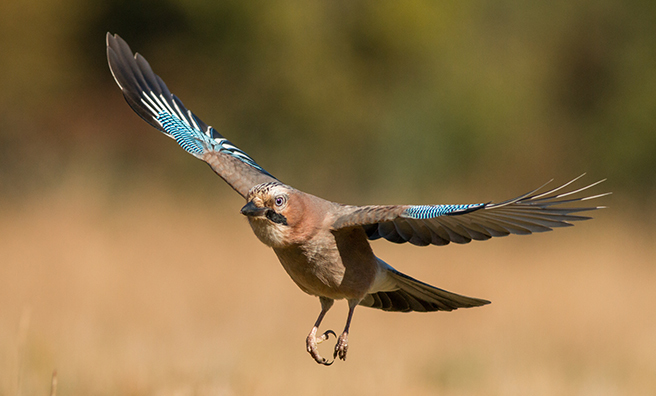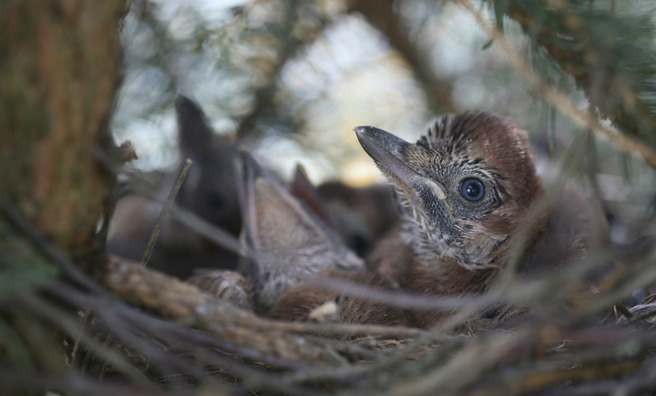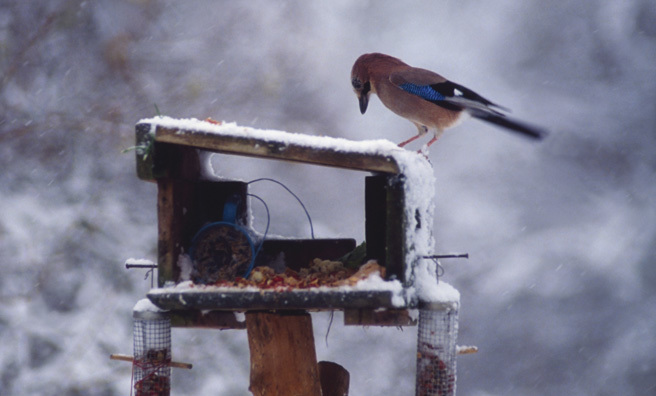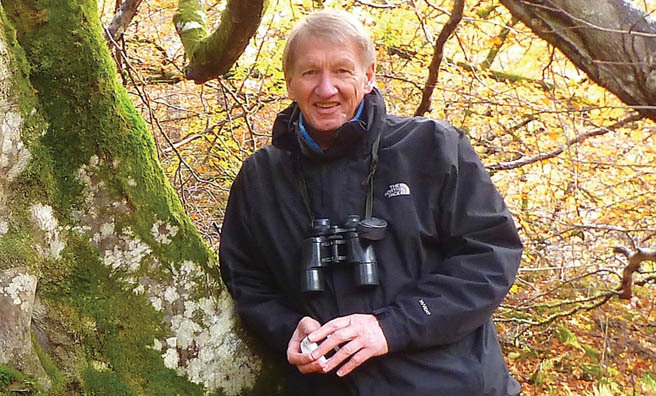Jay Is For January

Our nature expert Jim Crumley encounters a jay,
or, as the colourful bird is described in Gaelic, a
“sgreuchag-choille” – screamer of the woods
One of those half-dark-at-noon January days moved sluggishly through the afternoon, fuelled by that lethargic species of rain that makes almost no sound but has the capacity to saturate in minutes everything and everyone in its path
It was falling when I was having breakfast, mid-morning coffee, lunch and mid-afternoon coffee (long sessions at the writing desk are punctuated with excuses for getting up and crossing the room to the kettle), but just when I was thinking I needed the full-blown exercise of going downstairs to the bar where I might have the day’s first conversation with another human being, I glanced out of the window and saw pale light.
The rain had stopped and the last hour before dusk promised to be the brightest – or rather the least dark – of the day, so I postponed the pleasures of the bar, stepped into wellies, grabbed a jacket and binoculars, and went out into the sodden world.
You just never know what might turn up
The nearest walking option from the writing desk is the forest which climbs the hillside behind my writing eyrie.
It’s a Commission forest, so not the most promising in wildlife possibilities, but the track would at least be firm underfoot whereas every other option would be sodden and soft. In any case, the object of the exercise on such a day is just to be out, to breathe clean air, and… well, you just never know what might turn up.
The sky had just begun to lift from its base about halfway down the hillside, a process that had the effect of draping the trees in thin scarves of cloud, as if the forest was smoking, although commonsense would tell you that there are few circumstances less conducive to any kind of spontaneous combustion than such saturated windless-ness.
Apart from my own footfall, a trickle of water in the ditch at the side of the track and an occasional distant rumble from the main road far below, there was a conspicuous lack of sound. It was good to be out, but there was an unease about the forest in such a mood, and it communicated itself effortlessly into the mind of a solitary walker. Then the forest screamed.
I spun round to face the source of the sound
As screams go, it was not so much a damsel-in-distress affair but more the hysterical screech of one of Macbeth’s witches. There again, it appeared to emanate from high in the spruces, which would seem to rule out both. I spun round to face the source of the sound, at which point an answering scream sounded from the direction I had been facing, so I spun again, in time to catch a glimpse of the screamer as it threaded a buoyant, slightly bouncing flight-path between trees.
There was a flash of white, a hint of blue, a blur of tawny, another scream… then nothing at all.
The Gaelic word for it is “sgreuchag-choille” – screamer of the woods – which just goes to show how much the old Highlanders knew about the creatures whose company they kept. The English “jay” is prosaic to the point of boredom, especially for such an un-boring bird.
Jays rarely stray far from their territory
So I now knew for sure that I was somewhere between two jays, whose last known locations were about 100 yards apart. Jays rarely stray far from their territory unless they run out of acorns, which is their favourite food, and paired-up birds rarely stray far from each other. But whatever these two were doing on this spruce-drenched hillside they weren’t looking for acorns. The chances are, I reasoned, that they were a pair and they would reappear sooner or later. I also reasoned that there was half an hour of usable light before darkness fell and that my chances of seeing anything more interesting were slim, so I may as well sit where I stood, lean back against this spruce trunk and see if my reasoning bore fruit.
Ten minutes – and four screams – later, there were 10 jays on the forest track between 20 and 50 yards away from where I sat. Sometimes it just turns out that way and you reap a modest reward because you made the effort to be out there and trusted the rest to instinct and stillness.
I was now treated to the collected works
The birds appeared to be feeding, probably on beetles or spiders or some other forest floor bug lured into the open by the mild weather. The thing about the screaming, which is how you identify an invisible jay from quite a distance away, is that it is only the most obvious element in the jay’s copious vocabulary. Sitting as close to them as I was, and with no other sights or sounds to distract either me or them, I was now treated to the collected works, as all 10 birds kept up a sotto voce stream of chatter.
The most frequent voice was a short, monosyllabic, flutey “coo”, which is not at all what you might expect. There were several variations on the theme of a crow-like caw, but shortened like soft explosions. There were soft, throaty chortles, both deep-voiced and falsetto that reminded me a bit of my grandfather’s pet budgie, which is one of the more ludicrous images that my writer’s mind has contrived on a Scottish hillside.
I then decided that there was also something of the budgie about the jay’s exotic plumage – the pale, patterned head with the habitual raising of the small crown feathers into a “crest”, the black embellishments beneath the beak, the contrast of breast and back plumage and the black and white of wings and tail and the audacious flash of blue – it could easily have been Australian.
Jays like oakwoods because they like acorns
Ten jays is a bit of a windfall and may indeed have been a winter foraging party and had run out of acorns on its home patch. In that case, it had actually done well to have found this corner of the Highlands. Jays like oakwoods because they like acorns, but they also like deep cover to nest and roost in, and the spaciousness of oakwoods does not supply deep cover. So if they can find an oakwood with, say, a spruce forest nearby, that suits them particularly well. And here is a spruce forest with oakwoods to the south and to the north, so perhaps it is not so surprising that I should find such a midwinter gathering here.
Nevertheless, it is the first I have seen here, a fact that reflects the secretive nature of many aspects of the bird’s life. For despite its vivid plumage, its increasing willingness to take advantage of garden bird-feeders and its so-conspicuous voice, it remains something of an enigma, and is extraordinarily accomplished in the art of not being seen when it chooses.
It was soon in retreat trailing a wake of screamers
The restless gathering on the forest track suddenly took flight in a clamour of screams and a sparrowhawk looped down and sped after them. But the hawk was never born that could get the better of 10 jays and it was soon in retreat trailing a wake of screamers.
In the dead quiet that followed I eased myself up and out of what had been a very damp seat, and headed down into gathered dusk with the welcome destination of a room with a blazing fire and a glass of something distilled for just such an occasion as this on a far Hebridean island. It’s a great country we live in.
You can catch a new Wild About Scotland article from Jim in The Scots Magazine each month
- Baby jays looking for their next meal
- Look out for jays on bird tables
Jay facts
- The most colourful member of the crow family
- Nature watchers are more likely to hear the distinctive scream than see these shy birds
- Found across the UK, except the far north of Scotland
- There are 170,000 jays in the UK
More From Jim
Catch the latest column from Jim Crumley in each issue of The Scots Magazine, and click below to read some past features online









